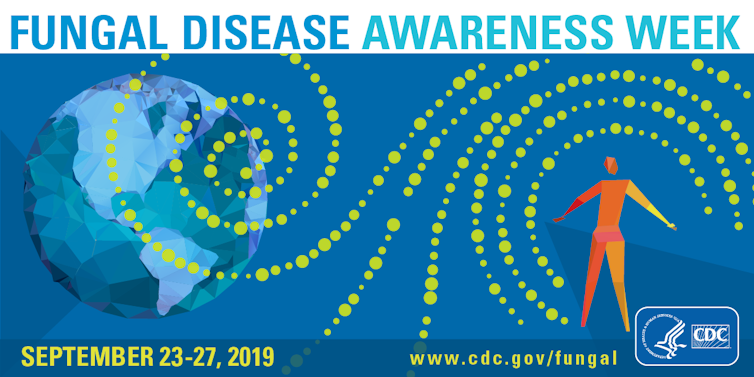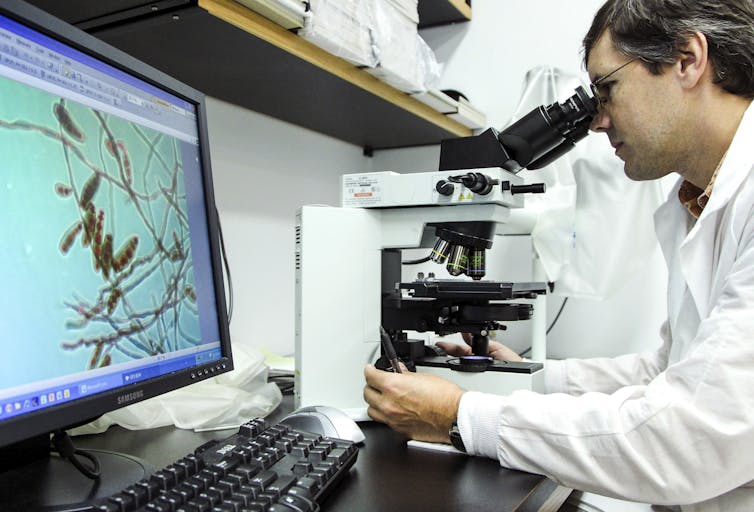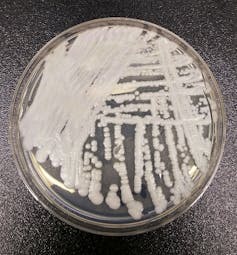Why does the CDC want us to 'Think Fungus'?
- Written by Murat Can Kalem, Ph.D. Candidate. Graduate Research Assistant, University at Buffalo, The State University of New York
When people think of infectious microbes, they typically think of bacteria and virus. There is, however, another enormous group of organisms that can affect our health: fungi.
It is estimated that there are 5.1 million[1] species of fungi on Earth, from the mushrooms that we eat to the microscopic fungi that can infect us. Most fungi are found in the environment – soil, trees, air and water – and they are all around us. Only a small subset of the 5.1 million – some 300 species[2] - pose a health threat and are capable of causing serious life-threatening infections. What makes these disease-causing species so special? How do these fungi impact our health?
The Centers for Disease Control and Prevention has designated the week of Sept. 23-27 as Fungal Disease Awareness Week[3] to boost the public’s understanding of how these microscopic organism can make humans sick. CDC handles between three and five fungal outbreaks per year[4]. This number was between one and two in 1990s. This increase in overall number of outbreaks is alarming.
 Fungal Disease Awareness Week logo.
Fungal Disease Awareness Week logo.
How does fungi infect us?
Fungi are all around us and people are infected when they inhale the microscopic fungi, fungal spores or through direct contact.
Sometimes the exposure to fungi is through contaminated products. That happened in the 2012 outbreak when more than 13,534 people were exposed to methylprednisolone (an anti-inflammatory drug), which was contaminated with a fungus[5] called Exserohilum rostratum that typically infects plants but not humans. In this outbreak, 753 cases of contaminated-product related fungal infections were reported and 61 people died[6].
Fungal outbreaks caused by understudied species are notably challenging because diagnostic tools and treatment options are insufficient.
Fungi are neglected
I am a microbiologist and am interested in fungi because fungal infections are becoming more common and are historically neglected[7].
I study a fungus species called Cryptococcus neoformans, and aim to unravel its molecular and cellular biology to better understand how it causes infections. It is one of the most devastating HIV/AIDS-related fungus, and especially was at the time of the AIDS epidemic in the 1980s and 1990s in the U.S.
People with weakened immune systems or those affected by conditions such as cancer, HIV/AIDS and organ transplantation are the populations most vulnerable to fungal infections in general.
The Cryptococcus infection presents as lung disease with nonspecific flu-like symptoms, such as fever, cough and chest pain. Cryptococcus can travel from the lungs to the brain and can cause Cryptococcal meningitis, and can be lethal if left untreated. Cryptococcus is in the environment and people are often infected by inhaling the fungi and the fungal spores. In fact, majority of the urban population is already infected with Cryptococcus.
With the development of therapies to fight HIV, the occurrence of AIDS-related fungal infections has decreased. But Cryptococcus is still a threat for organ transplant recipients and other vulnerable groups, and early diagnosis saves lives. Not to mention there are still 36.9 million people living with HIV worlwide[8], and cryptococcal meningitis is still one of the leading cause of death among the HIV/AIDS patients in sub-Saharan Africa[9].
 A researcher looks at the meningitis-causing fungus Exserohilum rostratum at the mycotic lab at the Centers for Disease Control and Prevention on Oct. 12, 2012 in Atlanta.
AP Photo/Pouya Dianat[10]
A researcher looks at the meningitis-causing fungus Exserohilum rostratum at the mycotic lab at the Centers for Disease Control and Prevention on Oct. 12, 2012 in Atlanta.
AP Photo/Pouya Dianat[10]
The number of fungal outbreaks are on the rise
In 2017, there was an unexpected outbreak of an infection called blastomycosis[11] in the metropolitan area surrounding Albany, New York, caused by the fungus Blastomyces. While the infection rate was 0.2 cases per 100,000 people in 2016, the infection rate increased to 2.2 cases per 100,000 people in 2017. Blastomyces are present in the environment and thrive in moist soil and in decomposing organic matter. Though mostly asymptomatic, pneumonia is often how blastomycosis manifests. Between 1990-2010 in the U.S. alone 1216 people died[12] of blastomycosis.
Far away in another region of the country, in the southwestern U.S., another fungal infection coccidioidomycosis[13] - also known as valley fever and caused by the fungus Coccidioides, has been threatening people and it has now spread to Washington state. People can get valley fever when spores are inhaled or when exposed to the contaminated soil.
Both blastomycosis and coccidioidomycosis are tricky to diagnose because they manifest with flu-like symptoms [14]that are not specific enough, making it hard to identify the cause and provide effective treatment in a timely manner. If left untreated, fungal infection that emerge as a lung infection may spread to other organs and even to the brain, causing deadly scenarios.
 This fungus is a harmful form of yeast that was first seen in a patient in 2009, in Japan. Scientists say it can be hard to identify with standard lab tests, and more cases are being reported as doctors are looking harder for it.
Shawn Lockhart/CDC via AP[15]
This fungus is a harmful form of yeast that was first seen in a patient in 2009, in Japan. Scientists say it can be hard to identify with standard lab tests, and more cases are being reported as doctors are looking harder for it.
Shawn Lockhart/CDC via AP[15]
Complicating matters further is the sudden appearance of patients infected with multi-drug-resistant Candida auris[16] in the U.S. hospitals. In this case fungal infection symptoms may be less noticeable because infection mostly occurs in already hospitalized patients with already existing symptoms. Patients often present with fever and chills during Candida auris infection of the blood. This fungus was first isolated in Japan and then spread to four other continents. There is supporting evidence that global warming plays a role[17] in the sudden emergence of Candida auris as a threat.
Global warming drives fungal infections
Most fungi often thrive at 12-30 degrees Celsius[18] (53.6-86 degrees Fahrenheit). During infection, fungi experience a sudden increase in the temperature – around 37 degrees Celsius (approximately 98.6 degrees Fahrenheit) – as fungi enter the human body; therefore, only fungi that can survive at body temperature and bypass the immune system can cause infection.
It is crucial to understand how fungi must change to survive at elevated temperatures. That’s because only species that can survive at 37 degrees Celsius and above can infect humans.
More fungal species are expected to adapt to survive at elevated temperatures as a result of global warming. How this adaptation will impact human health[19] is largely unclear, but the hypothesis is that the geographical distribution of infectious fungi may widen and more fungal species may gain potential to be infectious.
Loud and clear: ‘Think Fungus’
Fungal infections can be devastating, and they continue to emerge more rapidly than ever. This is in part due to increased number of people with weakened immune systems[20], environmental changes[21], and drug resistance issues. Fungal infections are hard to diagnose, which makes them challenging to treat.
It is important that we all “Think Fungus” especially when there’s an infection that antibiotics fail to clear. More people should be aware that fungi are a common – and growing – source of infection.
[ Deep knowledge, daily. Sign up for The Conversation’s newsletter[22]. ]
References
- ^ 5.1 million (doi.org)
- ^ some 300 species (www.cdc.gov)
- ^ Fungal Disease Awareness Week (www.cdc.gov)
- ^ between three and five fungal outbreaks per year (doi.org)
- ^ methylprednisolone (an anti-inflammatory drug), which was contaminated with a fungus (doi.org)
- ^ 61 people died (wwwnc.cdc.gov)
- ^ historically neglected (doi.org)
- ^ 36.9 million people living with HIV worlwide (www.hiv.gov)
- ^ HIV/AIDS patients in sub-Saharan Africa (www.cdc.gov)
- ^ AP Photo/Pouya Dianat (www.apimages.com)
- ^ blastomycosis (www.cdc.gov)
- ^ 1216 people died (dx.doi.org)
- ^ coccidioidomycosis (www.cdc.gov)
- ^ manifest with flu-like symptoms (www.cdc.gov)
- ^ Shawn Lockhart/CDC via AP (www.apimages.com)
- ^ Candida auris (www.cdc.gov)
- ^ global warming plays a role (doi.org)
- ^ 12-30 degrees Celsius (doi.org)
- ^ adaptation will impact human health (doi.org)
- ^ increased number of people with weakened immune systems (doi.org)
- ^ environmental changes (climate.nasa.gov)
- ^ Sign up for The Conversation’s newsletter (theconversation.com)
Authors: Murat Can Kalem, Ph.D. Candidate. Graduate Research Assistant, University at Buffalo, The State University of New York
Read more http://theconversation.com/why-does-the-cdc-want-us-to-think-fungus-123821


